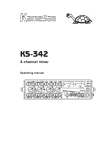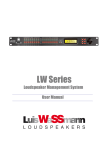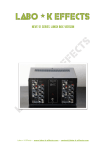Download Sigma KAMESAN KS-342 Specifications
Transcript
KS-6001 Sub-mixer Operating manual L PF L C R L PF L C R L PF L C R FD LINK 200 200 A-B P-48 Dy-M LINE +4 -30 -20 -70 P-48 PF L C R 20 0 A-B A-B PEAK L FD LINK Dy-M LINE PEAK +4 -30 -20 -70 P-48 Dy-M LINE PEAK +4 -30 -20 -70 20 0 A-B P-48 Dy-M LINE PEAK +4 -30 -20 -70 POWER KS-6001 Introduction Thank you for your purchase of the Kamesan KS - 6001. This sub audio mixer provides a flexible and powerful solution to your portable mixing needs, accepting up to four balanced microphone inputs, and mixing them into two before passing them to another mixer via a dedicated hardware connector integrated into the case design, or through a separate cable. Power is supplied from an outside source, either through the mating connector or a dedicated DC inlet. Before use, please read these operation instructions carefully, then keep them in a secure place for future reference. Notes and warnings The KS - 6001 may be used with the Kamesan KS -432 mixer, or may be operated with a DC power source or external rechargeable battery pack (up to 16 V output). If the KS - 6001 is used under different conditions, there is a risk of fire, damage to the unit, or personal injury. Note the following with regard to external power supplies: Make sure the polarity of the external powering device is correct. Make sure it is properly connected to the KS-432. Damage to the units may result if the joint connectors are not properly fitted and the power is turned on. Also, follow the common-sense precautions below: Do not allow liquids to come into contact with the unit or be spilled inside. Should this occur, fire, damage or malfunction may result. Make sure that no metal objects or easily inflammable substances inadvertently get inside the unit through holes or slots. Should this occur, fire, the unit may become damaged or start to behave erratically. Do not attempt to disassemble the unit as damage or malfunction may result. Notes on the Operating Environment Avoid using this unit in places with high heat or high humidity as damage or malfunction may result. When using in an 3 KS-6001 exceptionally cold environment, battery service life may be shortened, and there may be a drop in performance. If at all possible, use this unit in the temperature range as indicated in the specifications. When connecting this unit to external devices, be sure to read all related operation manuals and connect the devices correctly to each other. If there are mistakes in the connections, it is possible that either the KS - 6001 or the other unit(s) will be damaged. In the event that smoke or odors come from the unit, turn off the power and remove all batteries and external power supply sources at once. Contact your dealer or service representative. In the event of damage or injury caused by accidents, improper operation or functioning, the proper course of action shall be determined according to our service regulations. Please note that we cannot be responsible in any way for any loss of pre-recorded material. 4 KS-6001 Attaching the KS-6001 as a sub mixer Locking pins (bottom) and sockets (top) These locking pins and sockets locate the KS - 6001 in position when connecting it to another unit. They are secured and released with the locking levers Multipurpose connector This multipurpose connector carries signals to and from the KS - 6001 to the other unit. It is usually recessed, but may be released by sliding the small silver lever (marked RELEASE) using a small screwdriver or similar. Once the connector has been released, it is locked in the “Up” position but may be recessed again by sliding the release lever and pressing down the connector until it locks at the recessed position. Locking levers Multipurpose connector under cover Locking pins/sockets Connector cover if the KS - 6001 is being used as a standalone unit, you should always replace the cover and retain it in place with the screws provided. Keep the cover plate and the screws whenever the KS - 6001 is attached to another unit. Note: Large and small cushions that enable use with the KS-342 carrying case are supplied with this unit. These cushions are used with the carrying case as shown in the accompanying illustration. The large cushion should be used when the BP-3/8 (AA battery pack) is used. The smaller cushion is used when using the BH-1 (NP-1 battery pack). 5 KS-6001 ������ ������� ������� Side view of KS-342 with KS-6001 fitted, in case with cushion (gray) Carrying the unit In situations such as news reporting where the unit is to be carried during use, we recommend that the KS 342 carrying case be used. It can be attached to your belt on the carrying case and used together with the KS -342. If the unit is used with any other type of carrying case, make sure that all units are firmly affixed in the appropriate speciallydesigned carrying case. In the event of a major shock to the unit, there is a risk of damage to the connectors. For full instructions on how to fit the units into the carrying case and use it, read the operation instructions for the KS -342. Battery pack When using the KS - 6001 with the KS -342, there is a choice of two kinds of battery pack: the larger type being the BP-3/8, taking AA (type 3) batteries, and the smaller being the BH-1 (NP-1) battery pack type. 6 KS-6001 Parts of the KS-6001 Since the operation of the KS - 6001, once it has been fitted as a sub-mixer, is a relatively simple matter, this section contains the information you need to get up and running with the unit in most cases. Later sections contain more detailed information covering special circumstances. Side view Power switch Side locking lever 7 POWER 1 6 2 5 3 BUS MIX AUX (MONI) OFF Mix switch External power input MIX OUT (-20dBs) 4 CN Pin Assign 1.FG 2.Lch H 3.Lch C 4.Rch H 5.Rch C 6.+10 ~ 16V 7.0V Signal outputs and power multi-pin connecvor Side locking lever (explained above) Power switch (the dot indicates the ON position) Signal outputs and power multi-pin connector The mixer outputs are made at a level of –20 dBs and are balanced lowimpedance. Attach only suitable power supplies or battery packs as described here (between 16 and 20 V DC). Only use connectors supplied or approved by Kamesan. in the event of any doubt, please contact Kamesan or an appointed distributor directly. Mix switch The three-position switch is useful when using the KS - 6001 with the KS -342. It allows you to choose between BUS MIX: which sends the outputs to the KS -342’s buss mix, effectively turning the KS -342 into an 8-channel mixer. AUX, which sends the mixed signals from the KS - 6001 to the KS -342 as aux inputs (the KS -342 treats these differently from the BUS inputs); or OFF, where no signals are sent to the KS -342 (but power is still received through the connector). External power input Use this to provide external DC power to the unit—the tip is negative, and the voltage should be between 10 V and 16 V. If power is supplied through this input, this takes priority over power supplied through the multipin connector. 7 KS-6001 Side view The four XLR male connectors are used to connect appropriate microphones (or line-level sources) to the unit. Always ensure that microphones or line sources are correctly selected using the front panel selection switch, in order to avoid possible damage to the sources or to the KS - 6001. The XLR connectors are wired in the standard 1=ground, 2=hot, 3=cold configuration. There is also a locking lever visible on this side which should be used together with its counterpart on the other side when attaching or detaching the KS - 6001 to or from another unit. Front view LCF/PFL switch (x 4) Output bus assignment (x4) L PF L C R L PF L C R L Fader link (x 2) PF L C R FD LINK 200 Dy-M LINE 200 20 0 A-B A-B PEAK +4 -30 -20 -70 P-48 PF L C R POWER FD LINK A-B P-48 L Power indicator Dy-M LINE PEAK +4 -30 -20 -70 P-48 Dy-M LINE Input selector (x 4) PEAK +4 -30 -20 -70 20 0 A-B P-48 Dy-M LINE PEAK +4 -30 -20 -70 Master faders Channel fader (x 4) Peak indicator (x 4) Input trim control (x 4) LCF/PFL switch Use this control to sweep the low-cut filter frequency (–12dB/octave) between 20Hz and 200Hz. Though there is no way to turn this filter off, in practice, setting the cutoff frequency to 20 Hz has the same effect as turning it off, as most microphone systems are not sensitive to sounds in that frequency range. Press this control (it is non-latching) to perform a pre-fade listen (PFL) on the channel (only when connected to the KS -342, through the KS -342’s headphone monitoring system). More than one of these PFL controls can be pressed at the same time, 8 KS-6001 but in this case, the level and left VU meter indication (on the KS -342) will be lower than the actual values. Channel fader Turn clockwise to increase, and counterclockwise to decrease, the output level of this channel. Output bus assignment Use this to send the output of the channel to the left (L), right (R) or center (C – left and right) output busses. Input selector Use this to select between: P48 Condenser microphones requiring +48V phantom powering Dy-M Dynamic microphones LINE Line-level sources A-B - A-B type microphones Ensure that only microphones corresponding to the selection are connected to the appropriate inputs, otherwise damage may occur to the KS-6001 and to the microphones. PEAK indicator Shows when the pre-fader, post-gain signal is more than 28 dB above the optimum level. Input trim control Used to adjust the level of the signal fed to each channel. The amount of trim depends on the input setting: the blue figures indicate line-level settings, and the white figures indicate microphone levels. Channel fader link switches (FD LINK) When these switches are on (in the right position), the even-numbered fader controls the levels of both its own channel and the odd-numbered channel to its left. L & R master level controls Push to extend these controls and push again to recess them. These affect the level of the signal fed from the unit to the KS -342 through the MIX OUT connector. Power and status indicator This indicator serves two purposes. Firstly, it acts as a power indicator, showing when power is supplied to the unit. Secondly, the color of the indicator shows the current setting of the output bus as set by the side rotary control (TO 342). Green indicates the bus mix is active, yellow indicates AUX (for monitoring) and red indicates off, or a power supply below 9V. 9 KS-6001 If this (and/or the equivalent indicator on the KS -342) flashes read, you should immediately replace the batteries. Using the unit—some notes Before starting to use the KS - 6001, or connecting any equipment to it, make sure that the unit’s power switch is turned OFF. Before actually connecting microphones or other sources to it, make sure that the input selector switch is turned to the appro priate position for each channel. There is a risk of serious damage to equipment if the wrong selection is made! Make the multi-pin output/power connection. Turn on the power when the connections have been made. The unity gain position for each fader is around the 2 o’clock mark, as shown by a slightly thicker line at this position. Typically, you should set the individual channel faders to this position, the master controls to their maximum, and then adjust the trim controls so that the VU meters on the main mixer to which the KS - 6001 is connected show 0 dB on a nominal signal input. This provides sufficient headroom without forcing the head amp to work too hard. 10 KS-6001 Technical notes and specifications, etc. Inputs Input level (4 channels) Input impedance MIC – 70 to –30 dBs (balanced inputs) LINE –20 to +4 dBm (balanced inputs) MIX 1.2 kΩ LINE 600 Ω Headroom > 30 dB (pre-fader) Phantom powering either 48 V (maximum current of 8 mA) or A-B 12 V (maximum current of 40 mA) High-pass filter –12 dB/octave, sweepable cutoff between 20 Hz and 200 Hz Outputs Output level –20 dBs (from a 7-pin Cannon connector, electrically balanced, low-impedance output Maximum output +8 dBs (into 600Ω) Performance Figures measured when connected to KS -342. Frequency response 50 Hz to 15 kHz, < ±1.0 dB Signal-to-noise ratio MIC at –70 >55 dB (30 kHz LPF/RMS) LINE at +4 >68 dB (30 kHz LPF/RMS) Total harmonic distortion LINE < 0.5% (50 Hz thru 15kHz, nominal level) MONI < 0.5% (50 Hz thru 15kHz, nominal level) 11 KS-6001 Electrical characteristics Figures measured when connected to KS -342 External power supply Between +10 V and +16 V DC (maximum power 0.2A) Supplied through 7-pin Cannon connector or through dedicated DC input Typical power consumption 105 mA Battery life (KS-342 and KS-6001 used together) > 2 h (manganese cells) > 3 h (alkaline cells) > 6 h (NP-1 pack) Battery life ((KS-KS-6001 used as standalone) > 2 h (manganese cells) > 3 h (alkaline cells) > 6 h (NP-1 pack) Physical specifications Dimensions (w x d x h) 215 x 170 x 40 (mm) 8.5 x 6.7 x 1.6 (in) Weight 1.1 kg (2.4 lb) Connector pinout The XLR-7-11C connector used to provide power and to carry out the master bus signals is wired as follows: 1 FG 5 R-ch — 2 L-ch + 6 DC IN + 3 L-ch — 7 DC 0V 4 R-ch + 12 CH4 INPUT CH3 INPUT CH2 INPUT CH1 INPUT (XLR-3) (XLR-3) (XLR-3) (XLR-3) A-B 12 LINE P-48 Dy-M A-B 12 LINE P-48 Dy-M 13 A-B 12 LINE P-48 Dy-M INPUT SEL. P INPUT SEL. P GAIN HA MIC -70~-30 LINE -20~+4 H.P.F. ( 20~200Hz ) MIC -70~-30 LINE -20~+4 H.P.F. ( 20~200Hz ) MIC -70~-30 LINE -20~+4 H.P.F. ( 20~200Hz ) MIC -70~-30 LINE -20~+4 H.P.F. ( 20~200Hz ) POWER GAIN Peak GAIN Peak HA LINE A-B 12 GAIN Peak HA Peak HA P-48 Dy-M INPUT SEL. P INPUT SEL. P FD FD FD FD R C L OUTPUT SEL LINK R C L OUTPUT SEL R C L OUTPUT SEL LINK R C L OUTPUT SEL +B POWER/OUT Power Regulator P-48V (option) DC-DC Converter A-B12V DC-DC Converter PFL BA LINK PFL BA PFL BA LINK PFL BA BA MIX MIX BA BAL BA BAL to SS342 OUTPUT SELECT OFF R AUX IN R MIX BUS OFF L AUX IN L MIX BUS PFL TALLY L-SUB MIX R-SUB MIX EXT I/O TALLY (HA) PFL INS I/O R MAS L MAS AUX L AUX R PFL (to SS342) EXT. I /O EXT. I /O (+9~16V) EXT.DC IN JACK MIX OUT (-20dBs) EXT.DC IN (+9~16V) MIX IN MIX OUT MONI OUT AUX IN PFL IN P-48V EXT I/O POWER (XLR7-32) KS-6001 Block diagram PFL TALLY R-MIX BUS PFL L-MIX BUS KS-6001 About Kamesan Sigma Systems Engineering was started in 1972 to develop and design professional mixers for studio and remote broadcast applications. Today, following the “slow and steady” principle of the tortoise, we have built up our sales and our reputation to the extent that we now enjoy 95% of the Japanese portable mixer market. We have concentrated on two or three main areas in our design philosophy: compactness, in an industry which was traditionally dominated by large, heavy equipment; ease of use, since time is always of the essence in the environments where our products are used; and quality, to match the needs that today’s broadcasters require. Our head office is in Shinjuku, Tokyo, and as a small company, we are happy to listen to the ideas for product improvement suggested by you, the customers and users of our equipment. Making steady progress (like a tortoise, but maybe a little faster!), we hope to meet your requirements, now and in the future. Visit both of our Web sites at http://www.kamesan.co.jp and http://www.kamesan.info in order to find out more about what we’re doing, and to let us know what you are doing with Kamesan products. 14 Sigma Systems Engineering Co. Ltd. 3-5-2 Okubo Shinjuku-ku Tokyo 169- 0072 JAPAN Tel: +81 3 3204 2611 Fax: +81 3 3204 2250 e-mail: [email protected]




















